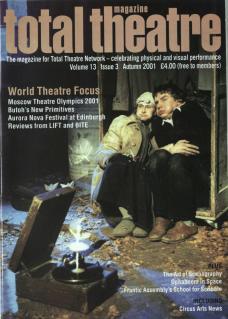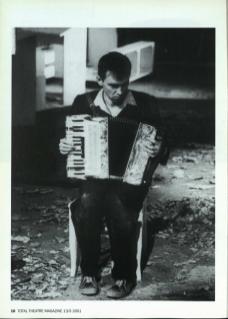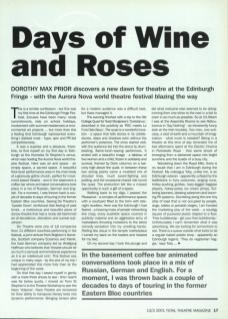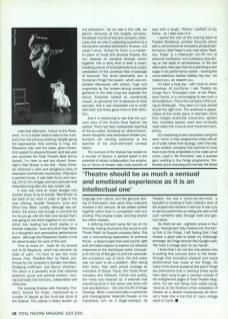This is a terrible confession – but this was my first time at the Edinburgh Fringe Festival. Excuses have been many: study commitments, kids on school holidays, involvement with summer residencies or environmental art projects... but more than this a feeling that Edinburgh represented everything I disliked most – hype, spin and PR-led competitiveness.
It was a surprise and a pleasure, therefore, to find myself on my first day in Edinburgh at the Komedia St Stephen's venue, which was hosting the Aurora Nova world theatre festival. Here was air and space – an empty space, a sacred space. A beautiful floor-level performance area in the main body of a gloriously gothic church, perfect for movement-based theatre – and in the basement a coffee bar where animated conversations took place in a mix of Russian, German and English. For a moment, I was thrown back a couple of decades to days of touring in the former Eastern Bloc countries. Seeing Do Theatre's Upside Down reinforced that feeling of past times – a meticulous and beautiful piece of dance-theatre that had a nicely old-fashioned air of decadence, alienation and surreal subversion.
Do Theatre were one of eighteen companies from eleven different countries performing in the festival, a joint venture from Brighton's Komedia, Scottish company Ecosmos and Fabrik, the East German company led by Wolfgang Hoffman who believes that ‘theatre should be as much a sensual and emotional experience as it is an intellectual one'. This festival was unique in many ways – by the end of my trip I had appreciated this more fully than at the beginning of the week.
On that first day I eased myself in gently with a mere three shows to see – this I learnt was far below quota. I moved on from St Stephen's to the Theatre Workshop to see the Kaos Volpone. Kaos Theatre are renowned for their ability to transpose literary texts into dynamic performance. Bringing Jonson alive for a modern audience was a difficult task, but Kaos managed it.
The evening finished with a trip to the Old College Quad for Teatr Modjeska's Coriolanus, described in the publicity as 'RSC meets La Fura Dels Baus'. The quad is a wonderful location – a space that tells stories in its cobblestones, steps and shadows even without the performer's presence. The show started well, with the audience led into the arena by drumbeating, flame-torch-waving performers. It ended with a beautiful image – a tableau of two women and a child, frozen in solidarity and survival, framed by Doric columns on a balcony high above the quad. In between these two strong points came a muddled mix of shouted lines, much sword-fighting and jostling, and the occasional chariot ride round the quad. The production felt like a missed opportunity in such a gift of a space.
Walking back to my digs, I passed the Pleasance – a complex of performance spaces with a courtyard filled to the brim with late-night revellers. Here was the Edinburgh I had feared – a heaving mass of people networking like crazy, every available space covered in publicity material and an aggressive army of marketeers thrusting invitations to the latest comedy sensation into my unwilling hands. Feeling like Jesus in the temple marketplace I turned my back on the traders and headed for my bed.
On my second day I took the plunge and did what everyone else seemed to be doing: running from one show to the next in a bid to cram in as much as possible. So at 10.00am I was at the Assembly Rooms to see Ridiculusmus in Say Nothing – an irreverently funny look at the Irish troubles. Two men, one suitcase, a clod of earth and a mountain of imagination – what more is needed? Being in a theatre at this time of day reminded me of lost afternoons spent at the Electric Cinema in Portobello Road – that same shock of emerging from a darkened space into bright sunshine and the bustle of a busy city.
Wandering down the Royal Mile, there is no doubt that I am in Edinburgh during the Festival. My colleague Toby, unlike me, is an Edinburgh veteran – apparently unfazed by the leafleteers in furry costumes, singing nuns, trolley-pushing gorillas, hairy-legged bagpipe players, hokey-pokey ice cream pimps, fluttering banners, bleating salesmen and booming PA systems. Stumbling along the one tiny strip of road that is not occupied by people, dogs, tables or portable stages, I am handed the marketing ploy of the week – a squidgy square of puckered plastic stapled to a flyer. ‘Free bubblewrap – get your free bubblewrap.’ Unfortunately I can't remember what it was advertising. We are looking for somewhere to eat. There is a queue outside what looks to be a regular baked potato shop – apparently an Edinburgh legend. ‘They do vegetarian haggis,' says Toby...
Later that afternoon, I return to the Pleasance. I'm in a better state to take in the hurly-burly than the previous evening. Despite giving the appearance that comedy is king, the Pleasance has, over the years, given consistent support to physical theatre (and last year was awarded the Total Theatre Best Venue Award). I'm here to see two shows. Kneehigh's Red Shoes is the first – Hans Christian Andersen's dark and dangerous story of obsession and female insurrection. Playing to a packed house, it was both funny and moving, full of rich images and soul-pictures that resonated long after the last curtain call.
It was very hard to move straight into another show, to try to banish Red Shoes to the back of my mind in order to take in the next offering, Scarlet Theatre's Love and Other Fairy Tales. Luckily, although very different, the shows had enough in common for me to just go with the flow and accept that I was going to link them together in my mind rather like reading two short stories in a themed collection. Love and other Fairy Tales is a thoughtful and provocative performance piece – although the Pleasance Cavern is not the ideal location for work of this sort.
Time to move on – back for my second visit to St Stephens, which has become my oasis of calm. I'm here to see two more shows. First, Petrified Skin by Fabrik, performed by the company's founder members, Wolfgang Hoffmann and Benno Voorham. The piece is a powerful duet that explores personal, social and political division, moving eventually into harmony, collaboration and resolution.
The evening finishes with Formalny Theatre's School For Fools, mentioned by a number of people as the must-see show of the festival. This places a heavy burden on any production – as we wait in the café, we glance nervously at the lengthy synopsis, translated chunks of text and company notes. I pray that we aren't subjecting ourselves to a convoluted narrative delivered in Russian, but needn't worry. School for Fools is a masterful piece of visual and physical theatre, the rich tapestry of narrative threads woven together into a story that is both a heartbreaking picture of schizophrenia and a joyful celebration of the universal rites-of-passage of boyhood. The show deservedly won a Scotsman Fringe First award – which was celebrated afterwards with cheers, hugs and snapshots by the sixteen-strong ensemble gathered in the little snug bar opposite the venue. Everyone looked so wonderfully uncool, so genuinely full of pleasure at their success, that it was impossible not to smile with them and throw good cheer in their direction.
And it is heartening to see that the success story of the Aurora Nova festival has spread. There has been widespread reporting of the so-called 'dumbing-up' phenomenon, where thoughtful and provocative theatre productions are winning audiences at the expense of the once-dominant comedy scene.
The success of the festival has rested on a number of factors: a spirited belief in the potential of artistic collaboration; the emphasis on forms of theatre that cross barriers of language and culture; and the genuine feeling of enthusiasm that came from everyone involved in the venture. All the artists worked together rather than in competition with one another. They shared meals, and they shared box office receipts.
A defining moment came for me on my third day, having returned to the venue to see Pookh Prakh by Russian company Akhe. This was a mesmerising exploration of primeval forces – a dreamscape that used sound, light and animated objects to explore our deepest responses to the archetypal world. Unusually for the city of fast get-ins and turnarounds, the company's use of sand, fire and water was not seen to be a problem. After taking their bows, they were joined onstage by members of Diquis Tiquis, the Costa Rican company who followed. Calmly and quietly, the mess was cleaned up. It seemed that everything done in this space was done with love and attention – 'Zen and the Art of Stage Cleaning'. When I comment later to performer and choreographer Alejandro Tossati on his impressive turn as a stage-sweeper, he says with a laugh, 'Where I perform is my home – so I take care of it.'
I spend the rest of the evening back at Theatre Workshop, another favourite venue with a commitment to innovative physical performance. Mat Fraser's one-man show Sealboy: Freak is a hilariously non-PC mix of personal confession and burlesque play-acting on the state of armlessness. In the bar afterwards, Mat says that he is planning a new stage in his performance career – reviving the circus sideshow. Gabba, Gabba, hey, hey – we respect you, we respect you.
It's been a long day – with more to come tomorrow. At lunchtime I see Théâtre de L'Ange Fou's Entangled Lives at the Pleasance Dome. It is encouraging to see such a full auditorium. This is the company's first outing to Edinburgh – they seem to have arrived at just the right time. The audience is appreciative of this lovely piece of dramatic mime that merges ensemble movement, spoken text, recorded spoken word and minimally used video into a sound and movement symphony.
It is reassuring to see companies using the word 'mime' in their programme notes with an air of pride rather than apology. Later that day, I saw another company that seemed to have their roots firmly embedded in the noble art of mime. Lazzi!'s Mr Pinnochio was a surprise gem nestling in the Fringe programme. Performed at the charming and intimate Hill Street Theatre, this was a 'circus-for-the-mind', a beautiful re-working of Carlo Collodi's story of the puppet who became a real boy. It was a joy to see two performers so willing and able to tell such wonderful tales through word and gesture alone.
So there we are – eighteen shows in four days. Having been fully initiated into the frenzy that is the Fringe, I left feeling that I had chosen a good year to break my Edinburgh embargo: as Fringe director Paul Gudgin said, ‘We have a vintage year on our hands.’
I know that I am not the only person who is putting that success down to the breakthrough that innovative physical and visual performance has made at the Fringe. So many of the shows lauded at this year's Fringe are productions that in previous times would have been lucky to get a mention outside of the enlightened pages of Total Theatre Magazine, but are now being more widely recognised as at the forefront of the restoration of theatre as a vibrant contemporary artform. Let's hope this is the first of many vintage years to come.



